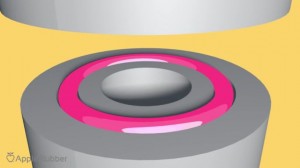Designing something as specific as an O-Ring involves rigorous testing and lots of attention to detail. Despite endless time and effort, sometimes it’s tough to achieve perfection — and O-Ring design flaws happen periodically.
Among the most common O-Ring design flaws is overcompression. By having thorough knowledge of overcompression issues, engineers can achieve the proper leak path ratio and avoid premature failure in O-Ring applications.
In the final segment of our technical video series, we share top tips for preventing leak paths from overcompressing. In under three minutes, you can expect to learn:
- Why engineers fail to achieve the proper O-Ring insertion force
- Which volume ratio percentages you should be using when displacing O-Rings
- Why rubber doesn’t actually compress volumetrically
- How to avoid premature seal failure in the beginning stages
- How to lengthen the overall sealing force and life of an O-Ring
Want to learn more?
For more information on our sealing capabilities, visit our Seal Design Guide or visit our Hot Topics page. What types of compression issues do you face? How do you overcome them? We’d love to hear your thoughts on Twitter @AppleRubber.
